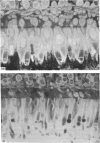Abstract
The amounts of endogenous retinyl palmitate, retinol and retinaldehyde were measured in the neural retina and retinal pigment epithelium (RPE) of predominantly cone (chicken), rod (rat) and more mixed (cat, human) retinae. The ratio of 11-cis to all-trans isomers of retinyl palmitate and retinol in the neural retina and the RPE increases progressively with the increase in diurnality of the species from rat to chicken. The membrane fractions of both chicken and bovine RPE enzymically isomerize all-trans retinol to 11-cis-retinol. Chicken neural retina membranes enzymically form 11-cis-retinol and all-trans-retinyl palmitate from all-trans-retinol. Light and electron microscopy revealed no contamination of chicken neural retina by RPE. Muller cells from chicken retina were isolated, cultured and characterized by immunocytochemical localization of cellular retinaldehyde-binding protein. Cultured chicken Muller cells form all-trans-retinyl palmitate, 11-cis-retinol and 11-cis-retinyl palmitate from all-trans-retinol and release most of the 11-cis-retinol into the medium. The results indicate that chicken neural retina and Muller cells in particular synthesize 11-cis-retinoids from all-trans-retinol.
Full text
PDF






Images in this article
Selected References
These references are in PubMed. This may not be the complete list of references from this article.
- Bernstein P. S., Law W. C., Rando R. R. Isomerization of all-trans-retinoids to 11-cis-retinoids in vitro. Proc Natl Acad Sci U S A. 1987 Apr;84(7):1849–1853. doi: 10.1073/pnas.84.7.1849. [DOI] [PMC free article] [PubMed] [Google Scholar]
- Bridges C. D., Alvarez R. A., Fong S. L., Liou G. I., Ulshafer R. J. Rhodopsin, vitamin A, and interstitial retinol-binding protein in the rd chicken. Invest Ophthalmol Vis Sci. 1987 Apr;28(4):613–617. [PubMed] [Google Scholar]
- Bunt-Milam A. H., Saari J. C. Immunocytochemical localization of two retinoid-binding proteins in vertebrate retina. J Cell Biol. 1983 Sep;97(3):703–712. doi: 10.1083/jcb.97.3.703. [DOI] [PMC free article] [PubMed] [Google Scholar]
- Cone R. A., Brown P. K. Spontaneous regeneration of rhodopsin in the isolated rat retina. Nature. 1969 Mar 1;221(5183):818–820. doi: 10.1038/221818a0. [DOI] [PubMed] [Google Scholar]
- Das S. R., Bhardwaj N., Gouras P. Synthesis of retinoids by human retinal epithelium and transfer to rod outer segments. Biochem J. 1990 May 15;268(1):201–206. doi: 10.1042/bj2680201. [DOI] [PMC free article] [PubMed] [Google Scholar]
- Das S. R., Gouras P. Retinoid metabolism in cultured human retinal pigment epithelium. Biochem J. 1988 Mar 1;250(2):459–465. doi: 10.1042/bj2500459. [DOI] [PMC free article] [PubMed] [Google Scholar]
- Flannery J. G., O'Day W., Pfeffer B. A., Horwitz J., Bok D. Uptake, processing and release of retinoids by cultured human retinal pigment epithelium. Exp Eye Res. 1990 Dec;51(6):717–728. doi: 10.1016/0014-4835(90)90057-2. [DOI] [PubMed] [Google Scholar]
- Flood M. T., Gouras P., Kjeldbye H. Growth characteristics and ultrastructure of human retinal pigment epithelium in vitro. Invest Ophthalmol Vis Sci. 1980 Nov;19(11):1309–1320. [PubMed] [Google Scholar]
- Fulton B. S., Rando R. R. Biosynthesis of 11-cis-retinoids and retinyl esters by bovine pigment epithelium membranes. Biochemistry. 1987 Dec 1;26(24):7938–7945. doi: 10.1021/bi00398a059. [DOI] [PubMed] [Google Scholar]
- Goldstein E. B. Cone pigment regeneration in the isolated frog retina. Vision Res. 1970 Oct;10(10):1065–1068. doi: 10.1016/0042-6989(70)90082-9. [DOI] [PubMed] [Google Scholar]
- Goldstein E. B., Wolf B. M. Regeneration of the green-rod pigment in the isolated frog retina. Vision Res. 1973 Mar;13(3):527–534. doi: 10.1016/0042-6989(73)90022-9. [DOI] [PubMed] [Google Scholar]
- Hood D. C., Hock P. A. Recovery of cone receptor activity in the frog's isolated retina. Vision Res. 1973 Oct;13(10):1943–1951. doi: 10.1016/0042-6989(73)90065-5. [DOI] [PubMed] [Google Scholar]
- Jones G. J., Crouch R. K., Wiggert B., Cornwall M. C., Chader G. J. Retinoid requirements for recovery of sensitivity after visual-pigment bleaching in isolated photoreceptors. Proc Natl Acad Sci U S A. 1989 Dec;86(23):9606–9610. doi: 10.1073/pnas.86.23.9606. [DOI] [PMC free article] [PubMed] [Google Scholar]
- Lewis G. P., Kaska D. D., Vaughan D. K., Fisher S. K. An immunocytochemical study of cat retinal Müller cells in culture. Exp Eye Res. 1988 Dec;47(6):855–868. doi: 10.1016/0014-4835(88)90068-1. [DOI] [PubMed] [Google Scholar]
- REUTER T. KINETICS OF RHODOPSIN REGENERATION IN THE EYE OF THE FROG. Nature. 1964 Jun 13;202:1119–1120. doi: 10.1038/2021119a0. [DOI] [PubMed] [Google Scholar]
- Tsin A. T., Alvarez R. A., Fong S. L., Bridges C. D. Use of high-performance liquid chromatography in the analysis of retinyl and 3,4-didehydroretinyl compounds in tissue extracts of bullfrog tadpoles and goldfish. Vision Res. 1984;24(12):1835–1840. doi: 10.1016/0042-6989(84)90015-4. [DOI] [PubMed] [Google Scholar]
- Tsin A. T., Lam K. W. Retinyl palmitate hydrolase activity in the bovine retina. Biochem Biophys Res Commun. 1986 Feb 13;134(3):1209–1214. doi: 10.1016/0006-291x(86)90379-7. [DOI] [PubMed] [Google Scholar]






